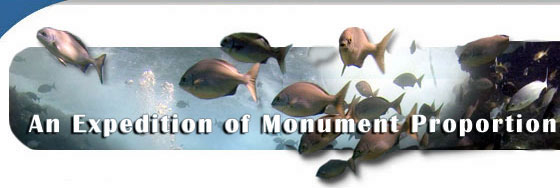|
Mission Log: July 6, 2006
Underwater Village
Claire Johnson
NOAA National Marine Sanctuary Program
Swim by any number of small coral heads in the middle of a sandy flat and you will see an entire underwater village. At the end of our last snorkel site and after putting away my underwater camera housing and my REEF fish count slate, I swam over to a small head of cauliflower coral (Pocillopora meandrina). Before I got close enough to scare them all away, there were approximately 45 Hawaiian domino damselfish (Dascyllus albisella) in sizes ranging from the size of a dime to larger ones about 2 inches across making their distinctive purring noises. There was also a small endemic saddle wrasse (Thalassoma duperrey), and a miniature oval butterflyfish (Chaetodon lunulatus). As I swam closer to get a better look a tiny, endemic bluestripe butterflyfish (Chaetodon fremblii) the size of a quarter, every single fish darted into a hiding place or tiny crevice in the coral head. Leaving the coral condominium appearing empty.
 |
| Thick finger coral (Porites duerdeni) provides shelter for a wide variety of reef fish.(Photo: Claire Johnson/NOAA) |
As Ellyn Tong and I explored this underwater village further, we continued to find little critters tucked away. The small saddle wrasse had wedged itself in between two fingers of the coral. On every dive down we discovered additional species tucked away, such as a miniscule Hawaiian turkeyfish (Pterois sphex) the size of a half dollar buying time until it will be large enough to recruit to the main reef and find a domain. Most of these juvenile fish will spend their young life zooming in and out of the coral crevices. Exploring the outside world in search of food and tucking in to avoid predation. Once these fish are big enough, most of them will recruit to the reef and spend the rest of their lives there.
This is the time of year that juveniles are in abundance, generally living symbiotically with the coral. In some cases, using the coral for protection, such as the Hawaiian domino damselfish, as it flutters above feeding on tiny plankton floating by. The damselfish may inadvertently share part of its meal with the coral polyps, making it a relatively fair arrangement. Reef fish are primarily driven by the desire to feed, avoid danger and eventually reproduce. The relationships formed on the reef, such as this small coral head are truly a matter of life and death.
 |
| Three juvenile amberjack (Seriola dumerili) taking up residence under the legs of a dead Laysan Albatross chick.(Photo: Ellyn Tong) |
Not all fish find protection in a small coral head while growing up. On a snorkel another day, we found three juvenile amberjack (Seriola dumerili) taking up residence under the legs of a dead Laysan Albatross chick. Until something larger decides to devour the free meal floating at the surface, these small amberjack will find sufficient shelter and protection under the bird until they are big enough to embark on their own pelagic adventures in the sea. They were quick-witted indeed. Any time we swam close by, they nearly darted away, weighing the consequences of leaving their protection for the great unknown.
 |
| A small head of cauliflower coral (Pocillopora meandrina) acts as a coral condominium for fish like the Hawaiian domina damselfish pictured.(Photo: Ellyn Tong) |
Although this coral head was a little larger than a basketball, this goes to show the significance of it for the life of nearly a hundred juvenile fish. If this branching head of cauliflower coral had been ruined by an anchor or a careless fisherman’s net an entire underwater community would have been impacted. The small fish would scatter to quickly find a new home and in the meantime likely become a meal for a larger, opportunistic fish. You can begin to imagine what the impact would be if several small coral condominiums were inadvertently destroyed at a near-shore reef. The consequences could easily compound over time and have long-term effects on the reef ecosystem. Think twice about your actions when you are near any coral, no matter how small. You may be impacting an entire little underwater village.
|



